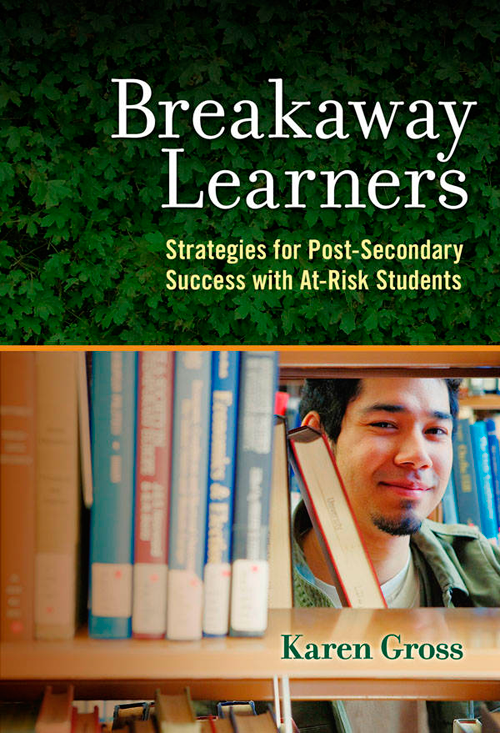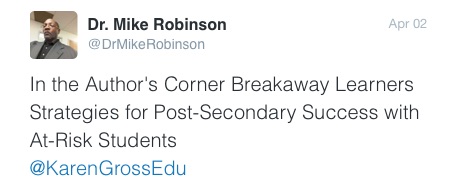Author
Educator
My work is focused on solutions to help students, educators and their institutions to thrive, not just survive.

My work is focused on solutions to help students, educators and their institutions to thrive, not just survive.

 Breakaway Learners: Strategies for Post-Secondary Success with At-Risk Students
Breakaway Learners: Strategies for Post-Secondary Success with At-Risk StudentsThis powerful book explores how institutions of higher education can successfully serve “breakaway” students—first-generation, low-income students who are trying to break away from the past in order to create a more secure future.
The gap between low-SES and high-SES students persists as efforts to close it have not met with great success. In this provocative book, Gross offers a new approach to addressing inequities by focusing on students who have succeeded despite struggling with the impacts of poverty and trauma.
Gross draws on her experience as a college president to outline practical steps that postsecondary institutions can take to create structures of support and opportunity that build reciprocal trust. Students must trust their institutions and professors, professors must trust their students, and eventually students must learn to trust themselves.

“A must-read for academics, policymakers, teachers, social service providers, police chiefs, and government officials.”
—Martha Kanter, former under secretary, U.S. Department of Education
“We need to pay attention to what Karen Gross says. Read this book, then share it.”
—Mark Huddleston, president, University of New Hampshire
“Karen Gross offers practical ideas based on her research and, more importantly, on her substantial leadership in assisting our nation’s colleges and universities serving at-risk students.”
—Marybeth Gasman, University of Pennsylvania
“Breakaway Learners explores how institutions of higher education can successfully serve “breakaway” students—first-generation, low-income students who are trying to break away from the past in order to create a more secure future. The gap between low-SES and high-SES students persists as efforts to close it have not met with great success. In this provocative book, Gross offers a new approach to addressing inequities by focusing on students who have succeeded despite struggling with the impacts of poverty and trauma. Gross draws on her experience as a college president to outline practical steps that postsecondary institutions can take to create structures of support and opportunity that build reciprocal trust. Students must trust their institutions and professors, professors must trust their students, and eventually students must learn to trust themselves.”
―Teachers College Press, Book Description
“More than a student-centered learning approach to education, Gross suggests that the educational system as a whole should assist students in developing lasticity, a term she uses to describe the quality necessary to enable breakaway students not only to complete their degrees, but also to succeed as adults in the working environment.”
―Reflective Teaching
“Breakaway Learners is a timely edition to the ongoing yet critical discussion about post-secondary student success. Gross’s work offers practical insights and examples for educators to tap into ‘at-risk’ students’ academic potential rather than solely focusing on their deficits.”
―Journal of Children and Poverty
“Karen Gross’s new concept of lasticity fundamentally challenges the norms of our education system while also seeking to create an authentic K-16 pipeline. She renames vulnerable students “breakaway students” and recognizes that the key to teaching these young people is by honoring that the act of learning requires trust. Her bold vision for education, grounded in real in-the-trenches experience, turns the current deficiency model into an interactive one, where trust is paramount and the educator is as much a learner and the learner is herself.
– Dr. Francis Bisselle, Head, Hathaway Brown School in Shaker Heights, Ohio; Former Head, Maple Street School, Manchester VT
“This book should be a must-read for the educational establishment. Too much educational policy and methodology is driven by barnacle-encrusted thinking. Karen Gross lays the groundwork for some new and refreshing thinking that is long overdue.”
–Wallace Altes, Business Consultant, Board Member, Former CEO Albany Chamber of Commence, Troy NY
“Breakaway Learners is a fresh take on becoming “educated.” It is written in a style that incorporates facts, theories, suggestions and pleasing personal anecdotes.”
–Jane Altes, Retired Senior College Administrator, Former Interim President Empire State College, Troy, NY
“This book signals to a holistic set of solutions to a whole set of problems. Karen points to how to construct bridges for learning. A Breakaway Learner: Ivan Figueroa”
–Ivan Figueroa, Director of Diversity Initiatives and Mountaineer Scholars Program, Southern Vermont College, Bennington, VT
“Karen Gross makes a compelling case in this book that a national focus on college access and completion is not enough! For success in college and the rest of one’s life, what happens between the bookends of access and completion is critical, especially for vulnerable students who are surmounting innumerable barriers that privileged students do not face. The book underscores the critical need for a high quality college education, the significance of adequate and necessary postsecondary preparation, and the imperative for greater, deeper collaboration among higher education and K-12 partners, community support services leaders, and government officials. This book is a must-read for academics, policy makers, teachers, social service providers, police chiefs, and government officials.”
–Dr. Martha Kanter, Executive Director, Civic Nation; Former US Undersecretary of Education
“In Breakaway Learners: Strategies for Post-Secondary Success with At-Risk Students, Karen Gross makes a compelling case for rethinking how we as college and university educators engage those students who come to our campuses with “curdled childhoods,” bearing burdens of poverty, inadequate K-12 educations, and dysfunctional (or absent) families. For many of us who work outside the thin stratum of America’s elite institutions, which ironically generate the most commentary about higher education while serving the fewest people, these young (and sometimes not so young) men and women constitute a large and growing portion of our student population. We need to pay attention to what Karen Gross says; the challenges are real, the need urgent. Drawing on decades of experience in higher education, particularly her years as president of Southern Vermont College, and reflecting on her own experiences as a “breakaway student,” Gross develops the concept of lasticity, a coinage she uses to pull together the characteristics necessary to facilitate the success of at-risk students, especially the five building blocks of elasticity, plasticity, “pivoting right,” reciprocity, and belief in self. In a policy landscape as contentious as that of education reform, many of Gross’s observations and recommendations will be controversial, as she readily acknowledges. But however sharply one might dissent from one point or another, no one will come away from this book without a deep sense of reward. Read this book, then share it.”
–Mark Huddleston, President of University of New Hampshire
As a K-12 principal for over 40 years in the fourth largest school system in the United States, I have worked at all levels and in all educational environments– from high performing International Baccalaureate schools to low performing Inner City schools. In all of these environments, one question sticks out—How do you properly educate low income, diverse student populations so that they are successful in the K-20 educational pipeline. The author tries to answer this question in this book. She makes two important points. First, that there is a need to recognize how the students have changed since our current educational process has been in place? And second, how will these students change in the decades to come? We need, as the author notes to respond to the realities of who students are and the lives that they are leading. We also need to develop methods to involve families in the educational process from birth forward. It is so important to make these families feel welcome in our schools, and to have them feel comfortable as they immerse themselves in their child’s educational success. The author explores the topic of how to develop the next generation of leaders by supplying them with a good start so that they are not left behind forever. The author also asks schools, teachers, and administrators TO CHANGE, because without change we cannot improve education or compete with other countries during the 21st century. It takes courage and tremendous effort to offer both a new paradigm and a new educational concept, that being lasticity. The author deserves enormous credit for rocking the proverbial boat.
–Irwin Adler, K-12 School Principal and Educational Leader, Dade County Public Schools, FL